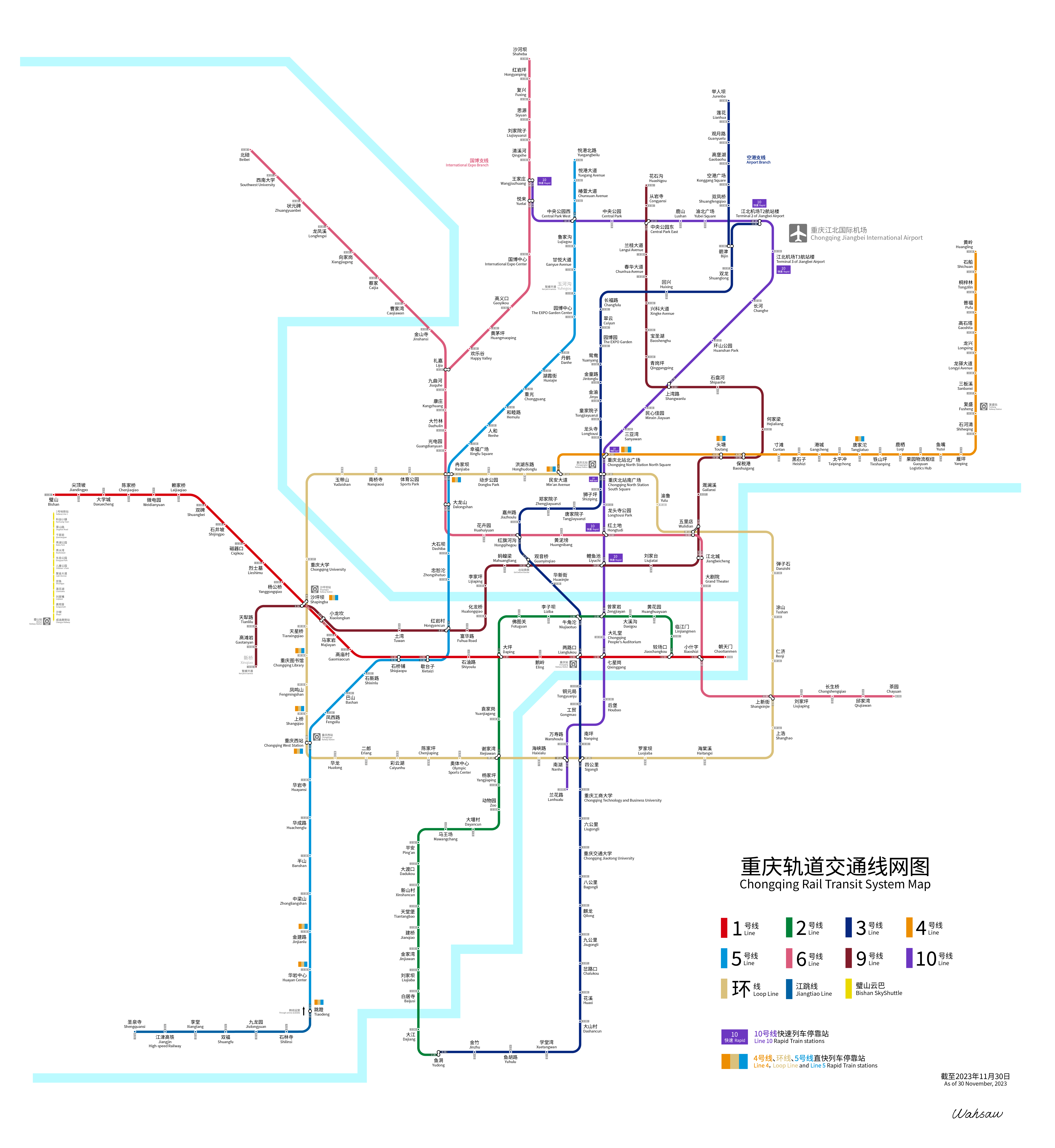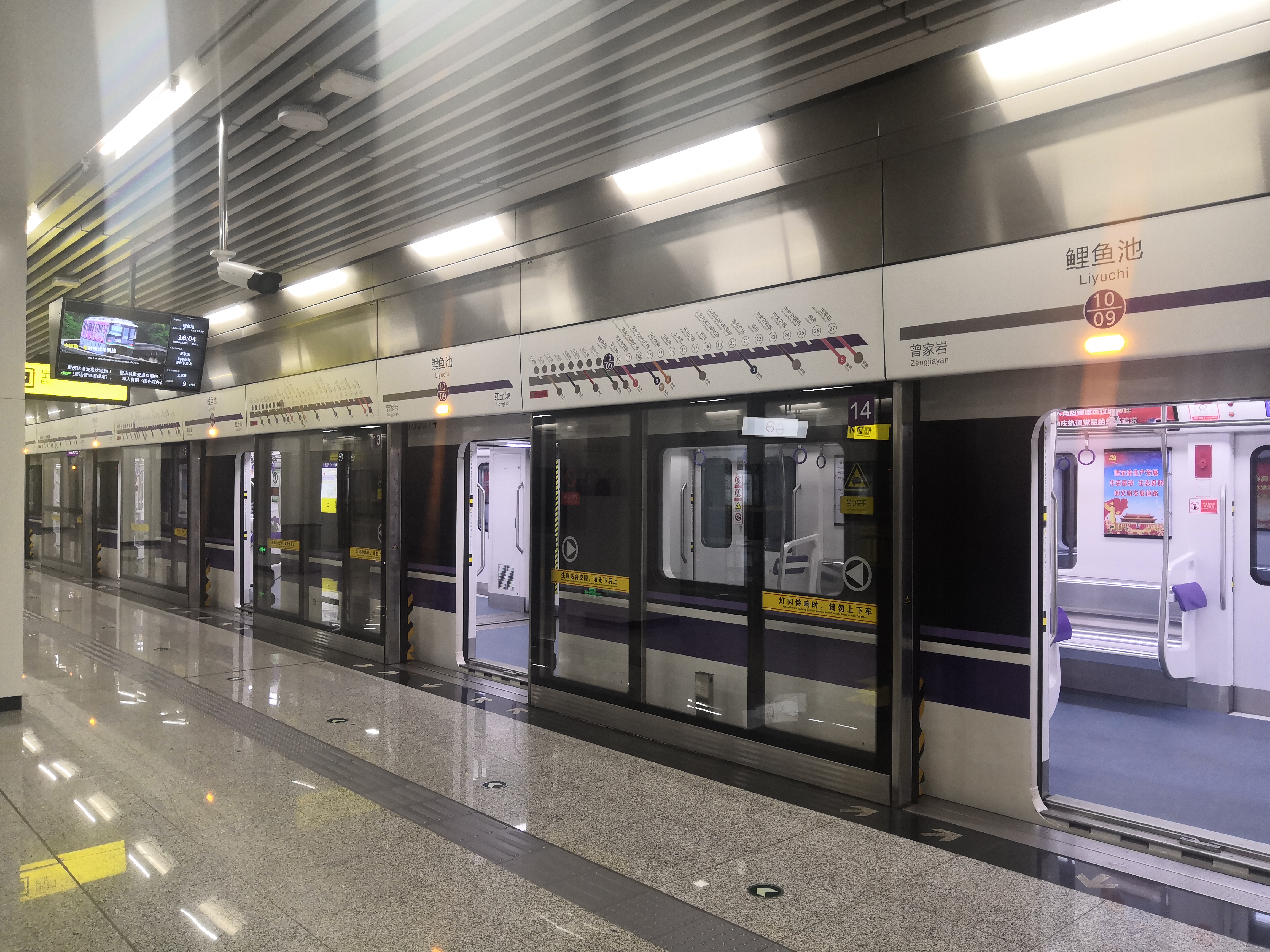|
Chongqing Monorail
The Chongqing Rail Transit (branded as CRT; also known as Chongqing Metro) is the rapid transit system in the city of Chongqing, China. In operation since 2005, it serves the transportation needs of the city's main business and entertainment downtown areas and inner suburbs. , CRT consisted of nine lines, with a total track length of . Lines 1, 4, 5, 6, 9, 10 and the Loop line are conventional heavy-rail subways, while Lines 2 and 3 are high-capacity monorails. To keep up with urban growth, construction is under way on Line 18 and Jiangtiao line, in addition to extensions to Lines 4, 5, 6, 9, 10. A network of 18 lines is planned. The Chongqing Rail Transit is a unique transit system in China because of the geography of Chongqing being a densely-populated but mountainous city, with multiple river valleys. Two lines use heavy-monorail technology, leveraging the ability to negotiate steep grades and tight curves and rapid transit capacity. They are capable of transporting 32,000 ... [...More Info...] [...Related Items...] OR: [Wikipedia] [Google] [Baidu] |
Chongqing
Chongqing ( or ; ; Sichuanese pronunciation: , Standard Mandarin pronunciation: ), alternately romanized as Chungking (), is a municipality in Southwest China. The official abbreviation of the city, "" (), was approved by the State Council on 18 April 1997. This abbreviation is derived from the old name of a part of the Jialing River that runs through Chongqing and feeds into the Yangtze River. Administratively, it is one of the four municipalities under the direct administration of the central government of the People's Republic of China (the other three are Beijing, Shanghai, and Tianjin), and the only such municipality located deep inland. The municipality of Chongqing, roughly the size of Austria, includes the city of Chongqing as well as various discontiguous cities. Due to a classification technicality, Chongqing municipality can claim to be the largest city proper in the worldthough it does not have the world's largest urban area. Chongqing is the only city ... [...More Info...] [...Related Items...] OR: [Wikipedia] [Google] [Baidu] |
Liyuchi Station
Liyuchi is a metro station of Line 9 and Line 10 of Chongqing Rail Transit in Jiangbei District of Chongqing Municipality, China. It serves the area surrounding East Jianxin Road. The station opened with Line 10 and its 2 platforms on 28 December 2017 and was expanded on 25 January 2022 with Line 9 in addition to 2 more platforms. Station Structure Line 9 Platform ;Platform Layout An island platform is in use for Line 9 trains travelling in both directions. This section of the station is located on the east of the Line 10 platform. Line 10 Platform ;Platform Layout An island platform is used for Line 10 trains travelling in both directions. As stations beyond here toward Lanhualu are part of Phase II of the metro line, which is still under construction, all South-bound Line 10 trains terminate here. The station will act as a reversing station using its single transition line for trains to switch direction until Phase 2 is completed. Before November 2022, only one side o ... [...More Info...] [...Related Items...] OR: [Wikipedia] [Google] [Baidu] |
Ba'nan District
Banan District (), formerly Ba County, is a district of Chongqing municipality. Geography and Climate Banan, situated in the south of Sichuan Basin, has a diversity of terrains including mountains, hills, wetlands and flood beds. The lowest point of the district is on its northern border with Nan'an District, at an altitude of 154 meters. The highest point is the top of Fangdou Mountain in the southeast of the district, at an altitude of 1132.6 meters. The climate of Banan is humid subtropical climate, typically found in Southern China and characterized by hot and humid summers, and mild winters. The average temperature of the year is 18.7 Celsius degrees, but sometimes the temperature can get as low as -1 degree in winter and as high as 41 degrees in summer. The annual precipitation of Banan usually fluctuates between 1000 and 1200 millimeters, with abundant rainfall from May to July. Administrative divisions Climate Transportation *China National Highway 210 Metro Banan i ... [...More Info...] [...Related Items...] OR: [Wikipedia] [Google] [Baidu] |
Bishan District
Bishan () is one of the districts of Chongqing, China, with a history of over 2000 years. Bishan is west of Chenjiaping in downtown Chongqing. Formerly a county, it became a district on 6 June 2014. Administrative divisions Bishan administers 2 subdistricts, 10 towns and 1 township and, with a total area of 915 square kilometers. History Bishan has a recorded history of over 2000 years. *In 316 BC, Jiangzhou County () was established here by the State of Qin. *In 757, Bishan County was established and administered by Yuzhou. *In 1102, Bishan was administered by Gongzhou, which is renamed from Yuzhou. *In 1189, Gongzhou was promoted to Chongqing Fu, which still administered Bishan County. *In 1259, Bishan County was merged into Ba County. *In 1483, Bishan County was re-established. *In 1662, Bishan County was merged into Yongchuan County. *In 1729, Bishan County was re-established again. *In 1914, Bishan County was administered by Sichuan province. *In 1997, Bishan County ... [...More Info...] [...Related Items...] OR: [Wikipedia] [Google] [Baidu] |
List Of Chongqing Rail Transit Stations ...
The following is a list of stations found within Chongqing Rail Transit. Loop line Line 1 Line 2 Line 3 Line 4 Line 5 Line 6 Line 9 Line 10 Notes References {{Chongqing Rail Transit Station, line1=yes, line2=yes, line3=yes, line4=yes, line5=yes, line6=yes, line9=yes, line10=yes, line0=yes * Metro Chongqing Rail Transit stations Chongqing Chongqing ( or ; ; Sichuanese pronunciation: , Standard Mandarin pronunciation: ), alternately romanized as Chungking (), is a municipality in Southwest China. The official abbreviation of the city, "" (), was approved by the State Cou ... [...More Info...] [...Related Items...] OR: [Wikipedia] [Google] [Baidu] |
Hitachi Monorail
The Hitachi Monorail System refers to the family of monorails offered by Hitachi Rail. List of notable Hitachi monorails Hitachi's designs are ALWEG-based, and are available in three configurations: All Hitachi trains except those on Japan's oldest operational monorail have floors entirely above all the wheels. Large * Kitakyushu Monorail, opened 1984 * Osaka Monorail, opened 1990 * Tama Toshi Monorail Line, opened 1998 * Line 2 & Line 3, Chongqing Rail Transit (China), opened 2005 & 2011 (Changchun Railway Vehicles Co., Ltd. also took part in the designing) Standard *Tokyo Monorail, opened 1964 *Okinawa Urban Monorail, opened 2003 * Palm Jumeirah Monorail, (Dubai, United Arab Emirates) opened April 2009 * Daegu Metro Line 3, (Daegu, South Korea) opened April 2015 (prototype set only, remaining 27 built by Woojin Industrial Systems) Small *Sentosa Express (Sentosa, Singapore), opened 2007 Panama Metro Line 3 Project Hitachi will supply its system for Line 3 of the Panama M ... [...More Info...] [...Related Items...] OR: [Wikipedia] [Google] [Baidu] |
Arch Bridge
An arch bridge is a bridge with abutments at each end shaped as a curved arch. Arch bridges work by transferring the weight of the bridge and its loads partially into a horizontal thrust restrained by the abutments at either side. A viaduct (a long bridge) may be made from a series of arches, although other more economical structures are typically used today. History Possibly the oldest existing arch bridge is the Mycenaean Arkadiko Bridge in Greece from about 1300 BC. The stone corbel arch bridge is still used by the local populace. The well-preserved Hellenistic Eleutherna Bridge has a triangular corbel arch. The 4th century BC Rhodes Footbridge rests on an early voussoir arch. Although true arches were already known by the Etruscans and ancient Greeks, the Romans were – as with the vault and the dome – the first to fully realize the potential of arches for bridge construction. A list of Roman bridges compiled by the engineer Colin O'Connor features ... [...More Info...] [...Related Items...] OR: [Wikipedia] [Google] [Baidu] |
Chaotianmen Bridge
The Chaotianmen Bridge (), is a road-rail bridge over the Yangtze River in the city of Chongqing, China. The bridge, which opened on 29 April 2009, is the world's longest through arch bridge. The continuous steel truss arch bridge with tie girders has a height of from middle supports to arch top, main span of and a total length of . It carries six lanes of traffic with a pedestrian walkway on each side on the upper deck. The lower deck has 2 traffic lanes on each side with the Chongqing Metro Loop Line running down the middle.RIA 1/2007Chaotianmen Bridge – world's longest-span steel arch bridge See also * Yangtze River bridges and tunnels The bridges and tunnels across the Yangtze River carry rail and road traffic across China's longest and largest river and form a vital part of the country's transportation infrastructure. The river bisects China proper from west to east, and ev ... * List of longest arch bridge spans References External links * Bridges co ... [...More Info...] [...Related Items...] OR: [Wikipedia] [Google] [Baidu] |
Double-deck Bridge
A bridge is a structure built to span a physical obstacle (such as a body of water, valley, road, or rail) without blocking the way underneath. It is constructed for the purpose of providing passage over the obstacle, which is usually something that is otherwise difficult or impossible to cross. There are many different designs of bridges, each serving a particular purpose and applicable to different situations. Designs of bridges vary depending on factors such as the function of the bridge, the nature of the terrain where the bridge is constructed and anchored, and the material used to make it, and the funds available to build it. The earliest bridges were likely made with fallen trees and stepping stones. The Neolithic people built boardwalk bridges across marshland. The Arkadiko Bridge (dating from the 13th century BC, in the Peloponnese) is one of the oldest arch bridges still in existence and use. Etymology The ''Oxford English Dictionary'' traces the origin of the wo ... [...More Info...] [...Related Items...] OR: [Wikipedia] [Google] [Baidu] |
Gaojia Huayuan Jialing River Rail Transit Bridge
Gaojia Huayuan Jialing River Rail Transit Bridge is a rail transit suspension bridge crossing the Jialing River between Shapingba District and Jiangbei District in Chongqing. The bridge carries trains for the Chongqing Rail Transit Loop line. It was put into use on December 18, 2018. The bridge is a cable-stayed bridge A cable-stayed bridge has one or more ''towers'' (or ''pylons''), from which cables support the bridge deck. A distinctive feature are the cables or stays, which run directly from the tower to the deck, normally forming a fan-like pattern ... with a total length of 577 meters, a width of 19.6 meters, and a main span of 340 meters and has one of the longest transit only bridge spans in the world. References {{coord missing, China Bridges in Chongqing Bridges completed in 2018 ... [...More Info...] [...Related Items...] OR: [Wikipedia] [Google] [Baidu] |
Cable-stayed Bridge
A cable-stayed bridge has one or more ''towers'' (or ''pylons''), from which cables support the bridge deck. A distinctive feature are the cables or stays, which run directly from the tower to the deck, normally forming a fan-like pattern or a series of parallel lines. This is in contrast to the modern suspension bridge, where the cables supporting the deck are suspended vertically from the main cable, anchored at both ends of the bridge and running between the towers. The cable-stayed bridge is optimal for spans longer than cantilever bridges and shorter than suspension bridges. This is the range within which cantilever bridges would rapidly grow heavier, and suspension bridge cabling would be more costly. Cable-stayed bridges were being designed and constructed by the late 16th century, and the form found wide use in the late 19th century. Early examples, including the Brooklyn Bridge, often combined features from both the cable-stayed and suspension designs. Cable-stay ... [...More Info...] [...Related Items...] OR: [Wikipedia] [Google] [Baidu] |





